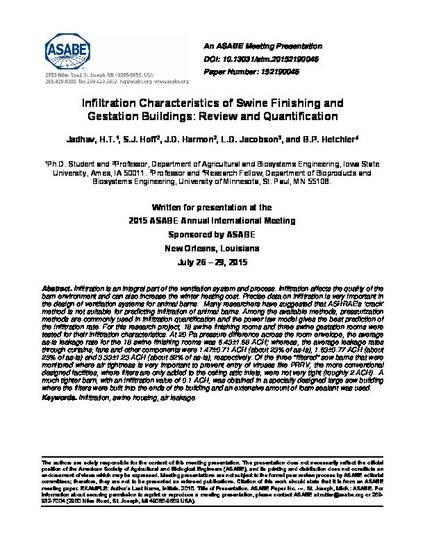
Infiltration is an integral part of the ventilation system and process. Infiltration affects the quality of the barn environment and can also increase the winter heating cost. Precise data on infiltration is very important in the design of ventilation systems for animal barns. Many researchers have suggested that ASHRAE’s ‘crack’ method is not suitable for predicting infiltration of animal barns. Among the available methods, pressurization methods are commonly used in infiltration quantification and the power law model gives the best prediction of the infiltration rate. For this research project, 18 swine finishing rooms and three swine gestation rooms were tested for their infiltration characteristics. At 20 Pa pressure difference across the room envelope, the average as-is leakage rate for the 18 swine finishing rooms was 6.43±1.68 ACH; whereas, the average leakage rates through curtains, fans and other components were 1.47±0.71 ACH (about 23% of as-is), 1.63±0.77 ACH (about 25% of as-is) and 3.33±1.23 ACH (about 52% of as-is), respectively. Of the three "filtered" sow barns that were monitored where air tightness is very important to prevent entry of viruses like PRRV, the more conventional designed facilities, where filters are only added to the ceiling attic inlets, were not very tight (roughly 2 ACH). A much tighter barn, with an infiltration value of 0.1 ACH, was obtained in a specially designed large sow building where the filters were built into the ends of the building and an extensive amount of foam sealant was used.
Available at: http://works.bepress.com/steven_hoff/123/

This proceeding is from 2015 ASABE Annual International Meeting, Paper No. 152190046, pages 1-13 (doi: 10.13031/aim.20152190046). St. Joseph, Mich.: ASABE. Posted with permission.